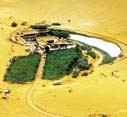Life
Sliver of shimmering silver in stark, sulfur sands
By Erik Nilsson (China Daily)
Updated: 2010-10-21 17:03
 |
Large Medium Small |
Water has for thousands of years directed the currents of development in Gansu province's Dunhuang city — the only desert oasis for hundreds of kilometers in any direction as the camel trots.
The centerpiece of the city's water table is Crescent Moon Lake, a bowed aquatic sliver shimmering in the cracks of several tumbling dunes.
|
 The Crescent Moon Lake looks like a mirage in the desert.[Photo/Agencies] |
| ||||
This water sickle's edges are fleeced by greenery, beyond which the stark yellow sands of the Gobi desert mash together in dunes that roll for about 200 km to the south. Surely, the island of lushness seems so surreally out of place in the otherwise barren wastelands that it appears as if it were a mirage. The topography of this parched landscape is shaped like the backs of the camels that plod across its slopes. Visitors can explore the swooping sand drifts while seated between these creatures' joggling humps.
And it's this very topography that has protected the lake from being swallowed by the area's frequent sandstorms. The roaring winds — from which the Resonating Sand Mountain (Mingshashan) takes its name — always blow east to west and from peak to peak across the dunes. This sends an aerosol of sand flying over, rather than into, the water.
But while the Crescent Moon Lake isn't in danger of being filled in from above, it is being sucked out from underneath. Dunhuang's groundwater — fed by about 20 minutes of rain a year — has become an even scarcer resource as the city's thirst for development continues to rapidly sponge it up. Over the past several decades, this has caused the pool to shrink into a puddle of its former self.
However, the Crescent Moon Lake's waning may be averted by ongoing city government campaigns to cap Dunhuang's population at 800,000 in the greater area, and to prohibit the drilling of new wells and cultivation of new land.
Despite its small size, the lake remains a big attraction for visitors.
Unlike the Silk Road-era travelers who came to the watering hole to quench their physical thirst, contemporary tourists come to drink in the scenery.
But liquid refreshment is still available — this oasis has its own drink stand, a pagoda proffering boiled apricot juice, a local specialty favored by locals for its hydrating qualities.
And visitors will not want to be parched while slogging up the dunes rising from the lake. It's a tough climb to the top, as every step buries climbers' legs up to their shins in sand. Vendors near the base rent out neon-orange, knee-high cloth booties that — in addition to making a fashion statement, of some kind — keep the desert out of wearers' shoes.
But while the distances up and down the sand piles are equal, the return trip is made much faster by "sand sledding". Visitors can hop aboard a bamboo toboggan and whoosh down the declivity, spraying rooster tails of dust behind them.
Whether by sled, foot or camelback — or by all three — exploring this oasis is a must for any traveler to Dunhuang.
As a fountainhead of scenic beauty and historical culture, Crescent Moon Lake shines bright as a star attraction for visitors to Gansu's otherwise desolate deserts.
